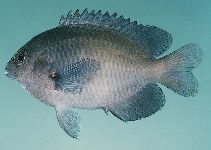|
Pomacentrus grammorhynchus Fowler, 1918 Bluespot damsel |

|
|
photo by
Randall, J.E. |
| Family: | Pomacentridae (Damselfishes), subfamily: Pomacentrinae | |||
| Max. size: | 9 cm SL (male/unsexed) | |||
| Environment: | reef-associated; marine; depth range 2 - 12 m, non-migratory | |||
| Distribution: | Western Pacific: Philippines, New Guinea, Rowley Shoals, Great Barrier Reef, and Palau (Belau), Truk, and Pohnpei in Micronesia. | |||
| Diagnosis: | Dorsal spines (total): 13-13; Dorsal soft rays (total): 14-15; Anal spines: 2-2; Anal soft rays: 14-15. Description: Overall yellow tan to dark brown, operculum and cheek vermiculations lavender, last dorsal rays base with saddle-like spot blue. Juvenile bright yellow, dorsal side black with stripes blue (Ref. 90102). Distinctive blue spot on top of the caudal peduncle (Ref. 1602). Adults have a bright yellow spot above the pectoral fin base (Ref. 48636). Body depth 1.8-2.0 in SL (Ref. 90102). | |||
| Biology: | Adults inhabit lagoons and passages among branching corals. They occur solitarily or in small groups. Feed mainly on benthic algae (Ref. 7247). Oviparous, distinct pairing during breeding (Ref. 205). Eggs are demersal and adhere to the substrate (Ref. 205). Males guard and aerate the eggs (Ref. 205). Diurnal species (Ref. 113699). | |||
| IUCN Red List Status: | Least Concern (LC); Date assessed: 23 September 2021 Ref. (130435) | |||
| Threat to humans: | harmless | |||